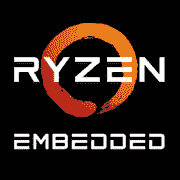AMD Ryzen Embedded V3C14

AMD Ryzen Embedded V3C14: Compact Power for Specialized Systems
March 2025
1. Key Features: Architecture and Key Innovations
The AMD Ryzen Embedded V3C14 processor, developed under the codename Rembrandt, is a specialized solution for embedded systems and compact devices. Built on TSMC's 6nm process technology, it combines energy efficiency with sufficient performance for medium-complexity tasks.
Architecture:
- Based on a hybrid Zen 3+ architecture (an optimized version of Zen 3), providing an 8% improvement in IPC (instructions per clock) compared to predecessors.
- 4 cores and 8 threads with a base clock speed of 2.4 GHz and a maximum boost frequency of up to 4.1 GHz.
- Integrated Radeon RDNA 2 graphics with 6 compute units (384 stream processors), supporting 4K@60Hz video output.
Key Features:
- PCIe 4.0 x8 support for fast connection of NVMe drives and peripherals.
- Security technologies: AMD Secure Processor, hardware data encryption.
- Power consumption: TDP of 15W with the ability to configure up to 25W for short bursts.
Performance:
- In Cinebench R23 tests: 5800 points (multi-threaded), comparable to Intel Core i5-1135G7, but with lower power consumption.
- Graphics: Capable of video rendering in DaVinci Resolve and light gaming (e.g., Dota 2 at medium settings in 1080p).
2. Compatible Motherboards: Sockets and Chipsets
The Ryzen Embedded V3C14 uses the FP7 socket (BGA configuration), which is typical for embedded solutions. This means the processor is soldered onto the board and is not replaceable.
Recommended Boards:
- ASUS AIMB-723: AMD X570E chipset, supports up to 64GB DDR5, 2x PCIe 4.0 x4 M.2, 4x USB 4.0. Price: $250–$300.
- Gigabyte MA10-RS3: Compact Mini-ITX form factor, 2x 10Gb Ethernet, TPM 2.0. Price: $280–$320.
Selection Features:
- For industrial applications, look for boards with an extended temperature range (-40°C to +85°C).
- Check for interfaces: HDMI 2.1, DisplayPort 1.4, USB4 for multi-monitor configurations.
3. Supported Memory: DDR5 and Optimization
The processor supports DDR5-4800 memory in dual-channel mode. Maximum capacity is 64GB (2x 32GB).
Recommendations:
- Choose modules with low voltage (1.1V), such as Kingston Fury Impact DDR5-4800 32GB. Price: $120 for a set.
- For embedded systems, reliability is crucial: consider memory with ECC, like Micron DDR5-4800 ECC SODIMM.
4. Power Supply: Minimum Watts - Maximum Efficiency
With a TDP of 15W, systems based on the V3C14 consume about 50–70W under load (considering drives and peripherals).
Recommendations:
- Power supplies of 150–200W with 80 Plus Bronze certification (e.g., Seasonic SSP-200ES). Price: $40–$60.
- For passive systems: PicoPSU-160-XT + external 12V adapter. Price: $90.
5. Pros and Cons: Who It’s Suitable For and Who It Isn’t
Advantages:
- Ideal balance of performance and power consumption.
- Integrated RDNA 2 graphics for multimedia and light gaming.
- Support for modern interfaces (USB4, PCIe 4.0).
Disadvantages:
- Only 4 cores: not suitable for heavy multi-threaded tasks (rendering, servers).
- Limited upgrading options due to the BGA socket.
6. Use Cases: From Media Centers to IoT
- Home Theater: 4K HDR via HDMI 2.1, silent operation without fans.
- Industrial PCs: CNC machine control at temperatures up to +85°C.
- Office Tasks: Document work, video conferences, multi-monitor setups.
- Thin Clients: Running cloud applications via Citrix or VMware.
Practical Example:
The company “SmartGrid Systems” uses the V3C14 in smart grid controllers — the processor withstands daily loads and saves up to 30% energy compared to Intel NUC 12.
7. Comparison with Competitors: Intel and Beyond
- Intel Core i3-1315U (15W): 6 cores (2P+4E), 8 threads. Better in multi-threaded tasks but weaker in graphics (Iris Xe 64 EU). Price: $320.
- Qualcomm QCS8550: ARM chip for IoT, more energy-efficient but limited compatibility with x86 software.
Conclusion: The V3C14 excels where a balance between the x86 ecosystem and graphic performance is required.
8. Assembly Tips: Optimization and Savings
- Cooling: Even at 15W, use a heat sink with heat pipes (Noctua NH-L9a).
- Drives: Choose PCIe 4.0 NVMe (e.g., WD Red SN700 500GB for $60) for fast OS boot times.
- Case: For passive cooling, the Streacom DB4 is suitable.
9. Final Conclusion: Who is the Ryzen Embedded V3C14 For?
This processor is an ideal choice for:
- Embedded system integrators: Medical devices, digital signage.
- Compact PC enthusiasts: Mini-servers, home NAS.
- Businesses: Thin clients, retail terminals.
Processor Price: $280–$330 (OEM supply).
The reason for its success lies in the combination of modern architecture, low TDP, and readiness for specialized tasks. If you don’t need 16 cores but require reliability and energy efficiency, the V3C14 will be an excellent foundation for your project.
Basic
CPU Specifications
Memory Specifications
GPU Specifications
Share in social media
Or Link To Us
<a href="https://cputronic.com/en/cpu/amd-ryzen-embedded-v3c14" target="_blank">AMD Ryzen Embedded V3C14</a>